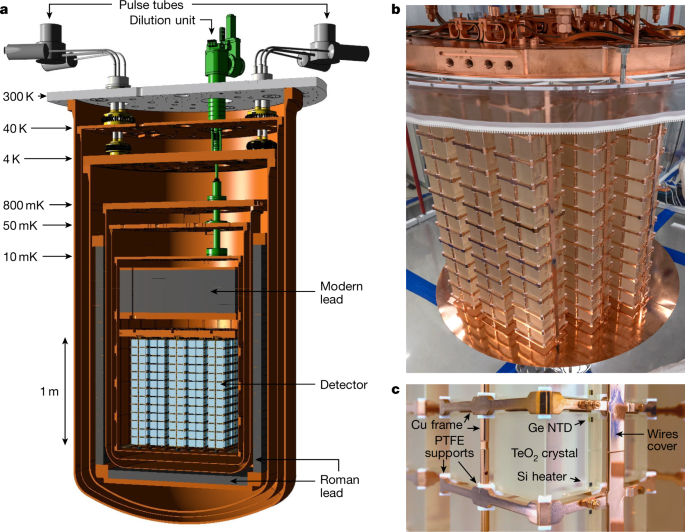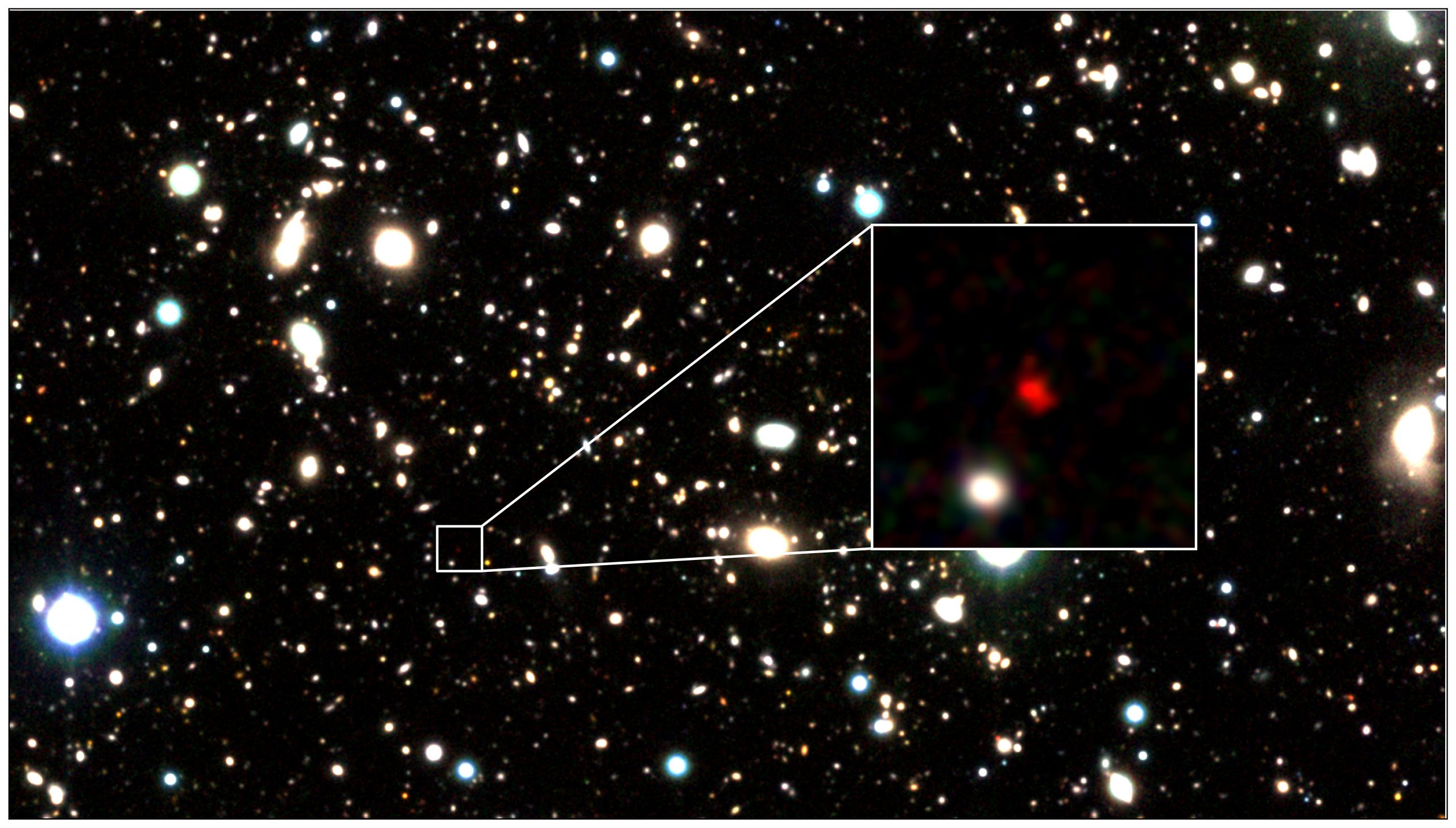物理学者はニュートリノの真の性質に迫り、我々の存在に関する基本的な疑問への解答に近づいているかもしれません。 Physicists are closing in on the true nature of the neutrino — and might be closer to answering a fundamental question about our own existence
2022-04-06 ローレンスバークレー国立研究所(LBNL)
・ニュートリノは、非常に珍しい粒子で、とても幽かでありながらどこにでもあるため、私たちが気づかないうちに定期的に私たちの体内を通過しているのです。
・CUOREは過去3年間、ニュートリノと反ニュートリノが同じ粒子である場合にのみ可能な、特徴的な核崩壊過程の証拠を見るために忍耐強く待ち続けてきました。CUOREの新しいデータは、この崩壊が全く起こらないとしても何兆年もの間起こらないことを示しています。CUOREが示したこの小さなファントムの振る舞いの限界は、素粒子・原子核物理学における次のブレークスルーを探る上で、そして私たち自身の起源を探る上で、極めて重要な役割を担っているのです。
・CUOREからの新しい結果は、過去3年間に集められた、他のどの高分解能探索よりも10倍も大きなデータセットに基づいています。
・CUOREは、イタリアの国立核物理研究所(INFN)とアメリカのバークレー研究所が主導する国際共同研究によって運営されています。CUOREの検出器本体は、INFNの施設であるLNGSの1マイル近い固い岩盤の下に設置されています。この実験では、米国エネルギー省の支援を受けた原子物理学者が科学的・技術的に主導的な役割を果たしている。CUOREの新しい成果は、『Nature』誌に掲載されました。
<関連情報>
- https://newscenter.lbl.gov/2022/04/06/cuore-team-places-new-limits-on-the-bizarre-behavior-of-neutrinos/
- https://www.nature.com/articles/s41586-022-04497-4
CUOREによるミリケルビン超低温を利用したマヨラナニュートリノの探索 Search for Majorana neutrinos exploiting millikelvin cryogenics with CUORE
D. Q. Adams, C. Alduino, K. Alfonso, F. T. Avignone III, O. Azzolini, G. Bari, F. Bellini, G. Benato, M. Beretta, M. Biassoni, A. Branca, C. Brofferio, C. Bucci, J. Camilleri, A. Caminata, A. Campani, L. Canonica, X. G. Cao, S. Capelli, L. Cappelli, L. Cardani, P. Carniti, N. Casali, E. Celi, D. Chiesa, M. Clemenza, S. Copello, O. Cremonesi, R. J. Creswick, A. D’Addabbo, I. Dafinei, S. Dell’Oro, S. Di Domizio, V. Dompè, D. Q. Fang, G. Fantini, M. Faverzani, E. Ferri, F. Ferroni, E. Fiorini, M. A. Franceschi, S. J. Freedman, S. H. Fu, B. K. Fujikawa, A. Giachero, L. Gironi, A. Giuliani, P. Gorla, C. Gotti, T. D. Gutierrez, K. Han, E. V. Hansen, K. M. Heeger, R. G. Huang, H. Z. Huang, J. Johnston, G. Keppel, Yu. G. Kolomensky, C. Ligi, R. Liu, L. Ma, Y. G. Ma, L. Marini, R. H. Maruyama, D. Mayer, Y. Mei, N. Moggi, S. Morganti, T. Napolitano, M. Nastasi, J. Nikkel, C. Nones, E. B. Norman, A. Nucciotti, I. Nutini, T. O’Donnell, J. L. Ouellet, S. Pagan, C. E. Pagliarone, L. Pagnanini, M. Pallavicini, L. Pattavina, M. Pavan, G. Pessina, V. Pettinacci, C. Pira, S. Pirro, S. Pozzi, E. Previtali, A. Puiu, C. Rosenfeld, C. Rusconi, M. Sakai, S. Sangiorgio, B. Schmidt, N. D. Scielzo, V. Sharma, V. Singh, M. Sisti, D. Speller, P. T. Surukuchi, L. Taffarello, F. Terranova, C. Tomei, K. J. Vetter, M. Vignati, S. L. Wagaarachchi, B. S. Wang, B. Welliver, J. Wilson, K. Wilson, L. A. Winslow, S. Zimmermann & S. Zucchelli
Nature Published: 06 April 2022

Abstract
The possibility that neutrinos may be their own antiparticles, unique among the known fundamental particles, arises from the symmetric theory of fermions proposed by Ettore Majorana in 19371. Given the profound consequences of such Majorana neutrinos, among which is a potential explanation for the matter–antimatter asymmetry of the universe via leptogenesis2, the Majorana nature of neutrinos commands intense experimental scrutiny globally; one of the primary experimental probes is neutrinoless double beta (0νββ) decay. Here we show results from the search for 0νββ decay of 130Te, using the latest advanced cryogenic calorimeters with the CUORE experiment3. CUORE, operating just 10 millikelvin above absolute zero, has pushed the state of the art on three frontiers: the sheer mass held at such ultralow temperatures, operational longevity, and the low levels of ionizing radiation emanating from the cryogenic infrastructure. We find no evidence for 0νββ decay and set a lower bound of the process half-life as 2.2 × 1025 years at a 90 per cent credibility interval. We discuss potential applications of the advances made with CUORE to other fields such as direct dark matter, neutrino and nuclear physics searches and large-scale quantum computing, which can benefit from sustained operation of large payloads in a low-radioactivity, ultralow-temperature cryogenic environment.


